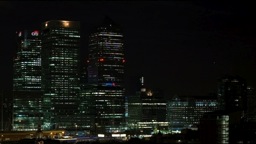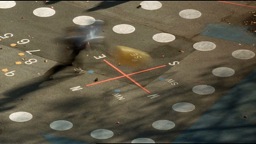One of the themes running through the work of artist film-maker William Raban is the creation of a counter-image of London to the classic and generally stereotypical representations of the city we are all too used to. I’m thinking here of work like Thames Film of 1986 and Island Race ten years later. His new film, About Now MMX, premiered last month at the Tate Modern, is very much in this mould.
Shot almost entirely in time-lapse on a 35mm camera with a telephoto lens, from the 21st floor of a tower block in East London, overlooking the city laid out below him, the river to the south, Canary Wharf to the south-west, his initial idea was to document the recession which had just hit at the moment the project was conceived.
The passage from conception to realization always involves posing and solving both technical and aesthetic problems, and Raban says that ‘Having decided to shoot most of the film in time-lapse, the initial idea of trying to show the effects of economic recession upon the London skyline became less important.’ A telephoto lens would accentuate the flattening effect of the aerial view from the tower bloc. Camera movement was vital for revealing connections and contrasts between different parts of city below, so he adopted a manually-controlled geared head to facilitate simple pans and tilts. At the same time, ‘The more I thought about how to shoot the film, it became increasingly clear to me that part of what I was doing was creating a cinematic map that would reveal connections between the various architectural, transport and social networks that comprise the city of London.’ The process of reducing the aerial view onto the surface of the screen would be analogous to the way the curving surface of the globe is reduced to two dimensions by the science of map projection.
And it works, with the help of a terrific soundtrack by David Cunningham in the manner of musique concrete (full of transposed traffic rumble, sounds of wind, a flapping flagpole, drumming, tinkling noises, all woven into a continuous and ominous enveloping throb). Just look at the lucid opening section. The opening shot is the open day in the room where the film is being shot, people milling and the view glimpsed behind them through the window at the far end. This is followed by the night-time lit-up grid of rows of office block windows—

—then the moon in the sky and a wider shot: the moon over the lighted city skyline, timed through to the lightening of the sky as dawn approaches. A shot of housing in the early morning; then looking down on a children’s playground, figures flitting across a compass painted in red and white on the asphalt, pointing north out of the bottom left of the frame, sorrounded by a rectangle of large white dots and a thick blue line.

Another group of schoolkids in another part of the playground (or another playground) picking their way along the blue lines of a grid painted at their feet, and some girls jumping around on a series of large red and white dots. Housing, market stalls, the river, the camera almost always panning or tilting in time-lapse so that moving objects flit by, people passing through like ghosts. An undulating motorway, the light railway. Canary Wharf belching hot steam into the winter air. In short, a set of chaotically superimposed and overlapping grids which holds everyone in its vice, and on the roof of a block of council flats, a banner reading: ‘CAPITALISM IS … THE CRISIS’.
About Now MMX is a city film which harks back more, I think, to Walter Ruttman’s Berlin, Symphony of a City than Vertov’s Man with a Movie Camera. Vertov’s city is an optimistic Communist ideal of life and vivacity. Ruttman portrays the modern capitalist metropolis where life is neurotically driven by over- and under-consumption, and a film which various reviewers of the time criticized for the inhumanity and abstraction of its portrayal of modern life. Raban’s film is hardly optimistic, but he’s created here a new cognitive screen-map of what our gut instincts already tell us about the dehumanisation of the crapulent capitalism of the early 21st century, strangely beautiful for such an unsettling portrayal.

One Response to William Raban’s new London film